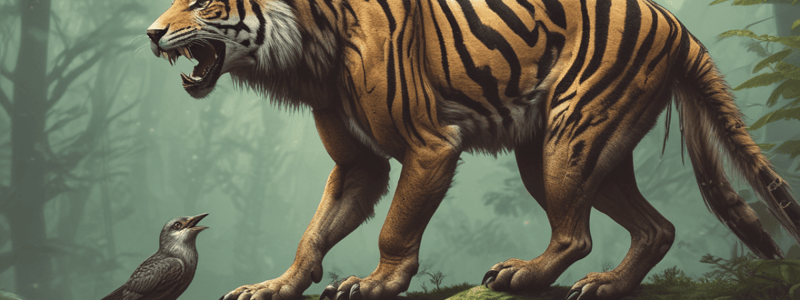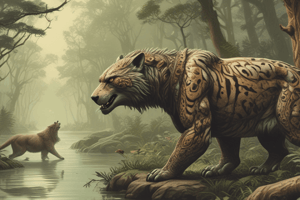Podcast
Questions and Answers
What is the primary aim of taking a reductionist view when investigating animal behaviour?
What is the primary aim of taking a reductionist view when investigating animal behaviour?
- To partition a specific behaviour into its component parts (correct)
- To study the habitat utilisation patterns of predators
- To assess the time + energy costs of prey behaviour
- To understand the predator-prey relationship
What is the primary goal of a predator in terms of prey?
What is the primary goal of a predator in terms of prey?
- To be vigilant and avoid being attacked
- To defend its carcass from other predators
- To locate and consume prey (correct)
- To find food and avoid being predated
What is a potential cost for prey that are constantly vigilant for predators?
What is a potential cost for prey that are constantly vigilant for predators?
- Time + energy cost (correct)
- Risk of being attacked
- Risk of parasitism
- Risk of injury
What is the concept of 'core areas' related to in the context of predators?
What is the concept of 'core areas' related to in the context of predators?
How can prey adapt to avoid predators according to the text?
How can prey adapt to avoid predators according to the text?
What is a potential benefit for prey that can assess the risk of predation and adjust their behaviour accordingly?
What is a potential benefit for prey that can assess the risk of predation and adjust their behaviour accordingly?
What is the main difference between the predator's and prey's perspective on energy costs?
What is the main difference between the predator's and prey's perspective on energy costs?
What is the main advantage of the reductionist approach in understanding animal behaviour?
What is the main advantage of the reductionist approach in understanding animal behaviour?
What is the primary consequence of predators not using all parts of their home range equally?
What is the primary consequence of predators not using all parts of their home range equally?
What is the ultimate goal of prey adopting strategies to avoid predators?
What is the ultimate goal of prey adopting strategies to avoid predators?
What is the possible explanation for the shift in crepuscular activity of brown antechinus in areas with high sugar glider abundance?
What is the possible explanation for the shift in crepuscular activity of brown antechinus in areas with high sugar glider abundance?
What is the likely outcome for prey species that evolved alongside predators but are now found on islands without predators?
What is the likely outcome for prey species that evolved alongside predators but are now found on islands without predators?
How do humans affect wildlife 'decision making'?
How do humans affect wildlife 'decision making'?
What is a unique feature of humans compared to other predators?
What is a unique feature of humans compared to other predators?
What is the general trend observed in species' daily activity in response to human activity?
What is the general trend observed in species' daily activity in response to human activity?
What is the effect of human activity on lions and spotted hyenas?
What is the effect of human activity on lions and spotted hyenas?
What is true about mega-fauna?
What is true about mega-fauna?
What is the result of increased human activity on prey species for lions?
What is the result of increased human activity on prey species for lions?
What is the result of increased human activity on prey species for leopards?
What is the result of increased human activity on prey species for leopards?
What is the main reason why prey tend to underestimate risk?
What is the main reason why prey tend to underestimate risk?
What is the term used to describe the idea that prey avoid predators to avoid risk?
What is the term used to describe the idea that prey avoid predators to avoid risk?
In the study on grey squirrels and pine martens, what did the results show?
In the study on grey squirrels and pine martens, what did the results show?
What is the term used to describe the phenomenon where a negative relationship between predator and prey arises due to reasons other than fear?
What is the term used to describe the phenomenon where a negative relationship between predator and prey arises due to reasons other than fear?
Why do red squirrels benefit from the presence of pine martens?
Why do red squirrels benefit from the presence of pine martens?
What is the main reason why patterns of spatial avoidance may not be permanent?
What is the main reason why patterns of spatial avoidance may not be permanent?
What is the main reason why predators are not active for the full 24 hours each day?
What is the main reason why predators are not active for the full 24 hours each day?
What is the term used to describe the phenomenon where a species varies its 24-hour pattern of activity within a species, e.g. between seasons?
What is the term used to describe the phenomenon where a species varies its 24-hour pattern of activity within a species, e.g. between seasons?
What was the result of the study on the 24-hour patterns of activity of species in a fragmented region of habitat in Australia?
What was the result of the study on the 24-hour patterns of activity of species in a fragmented region of habitat in Australia?
What is the main difference between the resolution of risk provided by different senses?
What is the main difference between the resolution of risk provided by different senses?
What is the primary reason why prey may not be able to perfectly avoid predators?
What is the primary reason why prey may not be able to perfectly avoid predators?
What is the term used to describe a phenomenon where a negative relationship between predator and prey arises due to reasons other than fear?
What is the term used to describe a phenomenon where a negative relationship between predator and prey arises due to reasons other than fear?
What is the primary reason why the negative relationship between pine martens and grey squirrels is not a true Landscapes of Fear?
What is the primary reason why the negative relationship between pine martens and grey squirrels is not a true Landscapes of Fear?
What is the primary difference between the resolution of risk provided by different senses?
What is the primary difference between the resolution of risk provided by different senses?
What is the primary reason why prey may vary their 24-hour pattern of activity within a species?
What is the primary reason why prey may vary their 24-hour pattern of activity within a species?
What is the primary advantage of monitoring the activity of prey in the presence of predators to prove the existence of Landscapes of Fear?
What is the primary advantage of monitoring the activity of prey in the presence of predators to prove the existence of Landscapes of Fear?
What is the primary reason why patterns of spatial avoidance may not be permanent?
What is the primary reason why patterns of spatial avoidance may not be permanent?
What is the primary benefit of the presence of pine martens for red squirrels?
What is the primary benefit of the presence of pine martens for red squirrels?
What is the primary difference between the activity patterns of red and grey squirrels?
What is the primary difference between the activity patterns of red and grey squirrels?
What is the primary reason why the reintroduction of predators in Yellowstone in 1995-1996 is a relevant example of Landscapes of Fear?
What is the primary reason why the reintroduction of predators in Yellowstone in 1995-1996 is a relevant example of Landscapes of Fear?
What is the likely consequence of human activity on the diet of lions and spotted hyenas?
What is the likely consequence of human activity on the diet of lions and spotted hyenas?
In areas with high sugar glider abundance, what did brown antechinus do to avoid them?
In areas with high sugar glider abundance, what did brown antechinus do to avoid them?
What is a characteristic of mega-fauna that makes them vulnerable to humans?
What is a characteristic of mega-fauna that makes them vulnerable to humans?
What is the term used to describe the phenomenon where species adjust their activity pattern to avoid predators or human activity?
What is the term used to describe the phenomenon where species adjust their activity pattern to avoid predators or human activity?
What is the outcome of the absence of predators on prey species that evolved alongside them?
What is the outcome of the absence of predators on prey species that evolved alongside them?
What is the effect of human activity on the daily activity patterns of species?
What is the effect of human activity on the daily activity patterns of species?
What is the characteristic of humans that sets them apart from other predators?
What is the characteristic of humans that sets them apart from other predators?
What is the result of human activity on the availability of prey species for leopards?
What is the result of human activity on the availability of prey species for leopards?
What is the outcome of temporal avoidance in areas with high sugar glider abundance?
What is the outcome of temporal avoidance in areas with high sugar glider abundance?
What is the consequence of human activity on wildlife 'decision making'?
What is the consequence of human activity on wildlife 'decision making'?
What is the primary consequence of predators not using all parts of their home range equally?
What is the primary consequence of predators not using all parts of their home range equally?
What is a common consideration for predators when selecting which prey to target?
What is a common consideration for predators when selecting which prey to target?
What is a potential benefit for prey that can assess the risk of predation and adjust their spatial patterns accordingly?
What is a potential benefit for prey that can assess the risk of predation and adjust their spatial patterns accordingly?
What is a key difference between the predator's and prey's perspective on energy costs?
What is a key difference between the predator's and prey's perspective on energy costs?
What is a common strategy adopted by prey to avoid predators?
What is a common strategy adopted by prey to avoid predators?
What is the primary reason why predators need to locate prey?
What is the primary reason why predators need to locate prey?
What is a likely consequence of prey not being vigilant for predators?
What is a likely consequence of prey not being vigilant for predators?
What is the main advantage of taking a reductionist view when investigating animal behaviour?
What is the main advantage of taking a reductionist view when investigating animal behaviour?
What is a potential cost for predators that are constantly chasing prey?
What is a potential cost for predators that are constantly chasing prey?
What is the primary reason why prey alter their spatial patterns to avoid predators?
What is the primary reason why prey alter their spatial patterns to avoid predators?
Flashcards are hidden until you start studying




